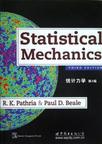统计力学
出版时间:2012-6 出版社:世界图书出版公司 作者:(美)帕斯瑞 著 页数:718
Tag标签:无
内容概要
这是一本研究生水平的统计力学经典教材。是以作者多年来在几所大学为研究生授课的讲义为蓝本而写成的。《统计力学(第3版)》初版于1972年,其内容涵盖了统计力学的标准内容,叙述清晰详细,深受读者欢迎。第2版对第1版的内容作了补充和删改,重写了关于相变理论的部分,增加了临界现象的重正化群理论的内容。《统计力学(第3版)》是第3版,增加了一些有关波色—爱因斯坦凝聚态和超冷原子气体的退化费米行为章节和讲述计算模拟方法和早期宇宙热动力学的两章;也增加了化学和相变平衡,扩充讲述了其与散布、量子场、有限尺寸效应和涨落耗散定理的相互关系。希望这个新的版本一如既往地为新一代的学习统计物理的学生提供坚实的基础。每章末增加了注释并附有习题。
读者对象:物理学专业的研究生、教师及科研人员。
作者简介
作者:(美国)帕斯瑞(R. K. Pathria) (美国)Paul D. Beale
书籍目录
preface to the third edition
preface to the second edition
preface to the first edition
historical introduction
1. the statistical basis of thermodynamics
1.1. the macroscopic and the microscopic states
1.2. contact between statistics and thermodynamics:physical
significance of the number (n, v,e)
1.3. further contact between statistics and thermodynamics
1.4. the classical ideal gas
1.5. the entropy of mixing and the gibbs paradox
1.6. the "correct" enumeration of the microstates
problems
2. elements of ensemble theory
2.1. phase space of a classical system
2.2. liouville's theorem and its consequences
2.3. the microcanordcal ensemble
2.4. examples
2.5. quantum states and the phase space
problems
3. the canonical ensemble
3.1. equilibrium between a system and a heat reservoir
3.2. a system in the canonical ensemble
3.3. physical significance of the various statistical quantities
in the canonical ensemble
3.4. alternative expressions for the partition function
3.5. the classical systems
3.6. energy fluctuations in the canonical ensemble:correspondence
with the microcanonical ensemble
3.7. two theorems - the "equipartition" and the "virial"
3.8. a system of harmonic oscillators
3.9. the statistics of paramagnetism
3.10. thermodynamics of magnetic systems:negative
temperatures
problems
4. the grand canonical ensemble
4.1. equilibrium between a system and a particle-energy
reservoir
4.2. a system in the grand canonical ensemble
4.3. physical significance of the various statistical
quantities
4.4. examples
4.5. density and energy fluctuations in the grand canonical
ensemble: correspondence with other ensembles
4.6. thermodynamic phase diagrams
4.7. phase equilibrium and the clausius-clapeyron equation
problems
5. formulation of quantum statistics
5.1. quantum-mechanical ensemble theory:the density matrix
5.2. statistics of the various ensembles
5.3. examples
5.4. systems composed of indistinguishable particles
5.5. the density matrix and the partition function of a system of
free particles
problems
6. the theory of simple gases
6.1. an ideal gas in a quantum-mechanical microcanonical
ensemble
6.2. an ideal gas in other quantum-mechanical ensembles
6.3. statistics of the occupation numbers
6.4. kinetic considerations
6.5. gaseous systems composed of molecules with internal
motion
6.6. chemical equilibrium problems
7. ideal bose systems
7.1. thermodynamic behavior of an ideal bose gas
7.2. bose-einstein condensation in ultracold atomic gases
7.3. thermodynamics of the blackbody radiation
7.4. the field of sound waves
7.5. inertial density of the sound field
7.6. elementary excitations in liquid helium ii
problems
8. ideal fermi systems
8.1. thermodynamic behavior of an ideal fermi gas
8.2. magnetic behavior of an ideal fermi gas
8.3. the electron gas in metals
8.4. ultracold atomic fermi gases
8.5. statistical equilibrium of white dwarf stars
8.6. statistical model of the atom
problems
9. thermodynamics of the early universe
9.1. observational evidence of the big bang
9.2. evolution of the temperature of the universe
9.3. relativistic electrons, positrons, and neutrinos
9.4. neutron fraction
9.5. annihilation of the positrons and electrons
9.6. neutrino temperature
9.7. primordial nucleosynthesis
9.8. recombination
9.9. epilogue
problems
10. statistical mechanics of interacting systems:the method of
cluster expansions
10.1. cluster expansion for a classical gas
10.2. virial expansion of the equation of state
10.3. evaluation of the virial coefficients
10.4. general remarks on cluster expansions
10.5. exact treatment of the second virial coefficient
10.6. cluster expansion for a quantum-mechanical system
10.7. correlations and scattering
problems
11. statistical mechanics of interacting systems:the method of
quantized fields
11.1. the formalism of second quantization
11.2. low-temperature behavior of an imperfect bose gas
11.3. low-lying states of an imperfect bose gas
11.4. energy spectrum of a bose liquid
11.5. states with quantized circulation
11.6. quantized vortex rings and the breakdown of
superfluidity
11.7. low-lying states of an imperfect fermi gas
11.8. energy spectrum of a fermi liquid: landau's phenomenological
theory
11.9. condensation in fermi systems
problems
12. phase transitions: criticality, universality, and scaling
12.1. general remarks on the problem of condensation
12.2. condensation of a van der waals gas
12.3. a dynamical model of phase transitions
12.4. the lattice gas and the binary alloy
12.5. ising model in the zeroth approximation
12.6. ising model in the first approximation
12.7. the critical exponents
12.8. thermodynamic inequalities
12.9. landau's phenomenological theory
12.10. scaling hypothesis for thermodynamic functions
12.11. the role of correlations and fluctuations
12.12. the critical exponents v and
12.13. a final look at the mean field theory
problems
13. phase transitions: exact (or almost exact) results for various
models
13.1. one-dimensional fluid models
13.2. the ising model in one dimension
13.3. the n-vector models in one dimension
13.4. the ising model in two dimensions
13.5. the spherical model in arbitrary dimensions
13.6. the ideal bose gas in arbitrary dimensions
13.7. other models
problems
14. phase transitions: the renormalization group approach
14.1. the conceptual basis of scaling
14.2. some simple examples of renormalization
14.3. the renormalization group: general formulation
14.4. applications of the renormalization group
14.5. finite-size scaling
problems
15. fluctuations and nonequilibrium statistical mechanics
15.1. equilibrium thermodynamic fluctuations
15.2. the einstein-smoluchowski theory of the brownian
motion
15.3. the langevin theory of the brownian motion
15.4. approach to equilibrium: the fokker-planck equation
15.5. spectral analysis of fluctuations: the wiener-khintchine
theorem
15.6. the fluctuation-dissipation theorem
15.7. the onsager relations
problems
16. computer simulations
16.1. introductionand statistics
16.2. monte carlo simulations
16.3. molecular dynamics
16.5. computer simulation caveats
problems
appendices
a. influence of boundary conditions on the distribution of quantum
states
b. certain mathematical functions
c. "volume" and "surface area" of an n-dimensional sphere of
radius r
d. on bose-einstein functionse. on fermi-dirac functions
f. a rigorous analysis of the ideal bose gas and the onset of
bose-einstein condensation
g. on watson functions
h. thermodynamic relationships
i. pseudorandom numbers
bibliography
index
章节摘录
版权页: 插图:
编辑推荐
《统计力学(第3版)》初版于1972年,其内容涵盖了统计力学的标准内容,叙述清晰详细,深受读者欢迎。第2版对第1版的内容作了补充和删改,重写了关于相变理论的部分,增加了临界现象的重正化群理论的内容。
图书封面
图书标签Tags
无
评论、评分、阅读与下载
用户评论 (总计8条)
- 大陆的书真的很便宜,这本是统计力学的经典教材了,希望以后大陆的出版社能拿到更多的外文书版权
- 原版太贵,舍尔求其次买了这本。
- 这本统计力学是本学科最经典的书了,就是好厚啊,不知多久能读完。
- 书当然写的非常好,据说在美国很受推崇,我想美国群众的眼睛也应该是雪亮的吧。印刷质量也不错。只是我这本的装帧有些问题,书皮比正常情况下要短,把里面的书页露出来2mm,不过懒得换了。我想这也许只是偶然,因为印刷和纸张都还算好。价格偏贵,但有700多页,打印会很厚,又或分成两本,不太方便。
- 是一本很好的书,对于学习统计的人是个很好的选择!
- 帕斯瑞的这本统计力学不敢说是很棒,但是的确很好
- 很好,是正版图书,印刷质量不错。
- 在很多网站上看到推荐,看了一下也可以,不过和之前的一版相比,价格涨了30元,但是还是比从国外买便宜。
